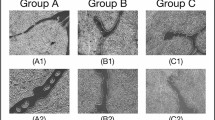Abstract
The study of the relationship among the manufacturing process, the structure and the property of materials can help to develop the new materials. The material images contain the microstructures of materials, therefore, the quantitative analysis for the material images is the important means to study the characteristics of material structures. Generally, the quantitative analysis for the material microstructures is based on the exact segmentation of the materials images. However, most material microstructures are shown with various shapes and complex textures in images, and they seriously hinder the exact segmentation of the component elements. In this research, machine learning method and complex networks method are adopted to the challenge of automatic material image segmentation. Two segmentation tasks are completed: on the one hand, the images of the titanium alloy are segmented based on the pixel-level classification through feature extraction and machine learning algorithm; on the other hand, the ceramic images are segmented with the complex networks theory. In the first task, texture and shape features near each pixel in titanium alloy image are calculated, such as Gabor filters, Hu moments and GLCM (Gray-Level Cooccurrence Matrix) etc.. The feature vector for the pixel can be obtained by arraying these features. Then, classification is performed with the random forest model. Once each pixel is classified, the image segmentation is completed. In the second task, a complex network structure is built for the ceramic image. Then, a clustering algorithm of complex network is used to obtain network connection area. Finally, the clustered network structure is mapped back to the image and getting the contours among the component elements. The experimental results demonstrate that these methods can accurately segment material images.
Similar content being viewed by others
References
Chen Y, Chen J. A watershed segmentation algorithm based on ridge detection and rapid region merging. in: Signal Processing, Communications and Computing (ICSPCC), 2014 IEEE International Conference on, IEEE, 2014:420 424.
Liu J, Chen J. An improved iterative watershed according to ridge detection for segmentation of metallographic image. Metallographic Image, 2012:8.
Albuquerque D, Victor H C, Joªo Manuel R S, Cortez P C, Quantification of the microstructures of hypoeutectic white cast iron using mathematical morphology and an artificial neural network. Inter- national Journal of Microstructure and Materials Properties, 2010, 5(1):52–64.
He W N, Zhang L L, Study on artificial neuronal networks applied on microstructure segmentation from metallographic images. Electronic Design Engineering, 2013, 3:49.
Azimi S M, Britz D, Engstler M, Fritz M, Mucklich F. Advanced Steel Microstructural Classification by Deep Learning Methods, Scientific reports, 2018, 8(1).
Long, J., Shelhamer, E. & Darrel, T. Fully convolutional networks for semantic segmentation. In IEEE Conference on Computer Vision and Pattern Recognition (CVPR) (2015).
Feichtinger H G, Luef F. Gabor Analysis and Algorithms[J]. Applied & Numerical Harmonic Analysis, 1998, 1:123–170.
Feichtinger H G, Thomas Strohmer Eds. Gabor analysis and algorithms: Theory and applications. Springer Science & Business Media, 2012.
Hu, M K. Visual pattern recognition by moment invariants. IRE transactions on information theory, 1962, 8(2): 179–187.
Dalal N, Bill T. Histograms of oriented gradients for human detection. Computer Vision and Pattern Recognition, 2005. CVPR 2005. IEEE Computer Society Conference on, 2005:1.
Haralick R M, Karthikeyan S. Textural features for image classification. IEEE Transactions on systems, man, and cybernetics, 1973, 6: 610–621.
Breiman, L. Random forests. Machine learning, 2001, 4(1): 5–32.
Breiman L, Friedman J H, Olshen R A, Stone C J. Classification and regression trees. 1984.
Cuadros O, Botelho G, Rodrigues F, Neto JB. Segmentation of large images with complex networks. SIBGRAPI 2012: 24–31. DOI: 10.1109/SIBGRAPI.2012.13.
B. B. Machado, L. F. Scabini, J. P. M. Orue, M. S. de Arruda, D. N. Goncalves, W. N. Goncalves, R. Moreira, and J. F. Rodrigues-Jr, A complex network approach for nanoparticle agglomeration analysis in nanoscale images, Journal of Nanoparticle Research, 2017, 19(2):65.
Suzuki S. and Abe K: Topological structural analysis of digital binary images by border following, CVGIP, 1985, 30:32–46.
Author information
Authors and Affiliations
Corresponding author
Rights and permissions
About this article
Cite this article
Lai, C., Song, L., Han, Y. et al. Material Image Segmentation with the Machine Learning Method and Complex Network Method. MRS Advances 4, 1119–1124 (2019). https://doi.org/10.1557/adv.2019.7
Published:
Issue Date:
DOI: https://doi.org/10.1557/adv.2019.7




